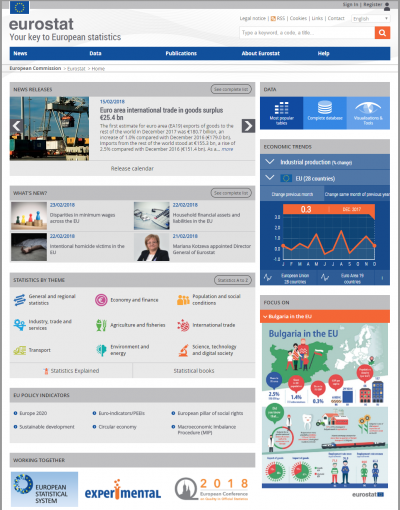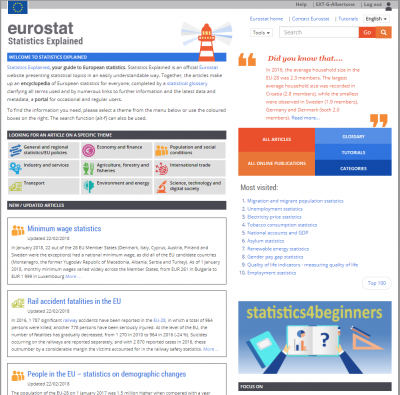Archive:Being young in Europe today - introduction
This article has been archived.
This is one of a set of statistical articles that forms Eurostat’s flagship publication Being young in Europe today.
Full article
About this publication
Being young in Europe today presents some of Eurostat’s most interesting data concerning the situation of younger people in the EU today. Being young in Europe today does not claim to be an exhaustive publication, but it provides an overview of the wealth of information that is available on Eurostat’s website and within its online databases. It provides a balanced set of indicators, with a broad cross-section of information.
This 2020 edition describes the situation in the EU, its Member States, the United Kingdom and the EFTA countries, generally up to the year 2019 (with some population projections through to 2050). As a consequence, first findings of COVID-19 related implications are not shown in this edition of Being young in Europe today and the full scale of the crisis will only be revealed if a future edition of the publication is produced.
What can you find in this publication?
Being young in Europe today is divided into seven chapters covering population, family and society, health, education, access to and participation in the labour market, living conditions and the digital world. The information presented in this publication covers children and young people and generally presents data for all those aged less than 30 years (subject to data availability).
There is no fixed definition to distinguish between children and young people, although the dividing line between the two is usually either 16 or 18 years. The information presented in this online publication reflects the age classes that were used in each source from which the tables and figures have been compiled.
Each chapter of Being young in Europe today contains data and background information relating to a wide range of EU statistics. More information on statistics covering youths can be found on Eurostat’s website, while there is a collection of subject specific data on youths that forms part of Eurostat’s online database.
Young Europeans
To complement Being young in Europe today, Eurostat has developed an interactive tool that provides information to young internet users in a fun way. It presents data for young people (aged 16 to 29 years) across four main areas: family, work, free time and studies, and the internet.
About EU policy initiatives relating to children and young people
The EU has set up several initiatives to promote children and young people, providing social investment in younger people to combat inequalities and promoting dialogue between younger people and policymakers; some of the most recent and pertinent initiatives are covered below.
The European Platform for Investing in Children (EPIC)
On 20 February 2013, the European Commission (EC) adopted Recommendation 2013/112/EU on Investing in Children — breaking the cycle of disadvantage as part of its social investment package. The recommendation proposed a long-term social strategy to support children and to help mitigate the effects of the global financial and economic crisis. The recommendation provides guidance for EU Member States on how to tackle child poverty and social exclusion through measures such as family support and benefits, quality childcare and early-childhood education. Social investment in individual capacities during early years is particularly beneficial for children from a disadvantaged background and can provide large social returns. Such investment is also considered a crucial factor in breaking cycles of intergenerational transmission of poverty.
The European Platform for Investing in Children (EPIC) is an evidence-based online platform that provides information about policies that can help children and their families face a range of socioeconomic challenges. It also helps EU Member States monitor and implement activities that have arisen from the Recommendation for Investing in Children. This platform is used to collect and disseminate innovative practices that have a positive impact on children and families across the Member States.
The EU’s Youth Strategy
In 2009, the European Council adopted Resolution 2009/C 311/01 on a renewed framework for European cooperation in the youth field (2010-2018), which set the stage for the EU’s youth strategy. The Resolution was the outcome of the European Commission’s efforts to promote dialogue between the population of younger people in the EU and policymakers, with the aim of increasing active citizenship, fostering social integration, and ensuring the inclusion of the young in EU policy development.
The EU’s youth strategy for 2010-2018 pursued two overall objectives:
- to provide more and equal opportunities for young people in education and in the job market; and
- to encourage young people to actively participate in society.
To achieve these objectives, the EU followed a dual approach of:
- specific youth initiatives, targeted at young people to encourage non-formal learning, participation, voluntary activities, youth work, mobility and information;
- ’mainstreaming’ cross-sector initiatives designed to ensure youth issues were taken into account when formulating, implementing and evaluating policies and actions in other fields with a significant impact on young people, such as education, employment or health and well-being.
The EU’s youth strategy was renewed in November 2018 when the European Council adopted Resolution 2018/C 456/01 on a framework for European cooperation in the youth field: the European Union youth strategy 2019-2027. This revised strategy is designed to bring the EU closer to young people and to help address issues of concern to them by focusing on three main areas of action:
- engage — to encourage young people to participate in civic and democratic life;
- connect — to connect young people across the EU and beyond by promoting volunteering, opportunities to learn abroad, solidarity and intercultural understanding;
- empower — to support youth empowerment through boosting innovation in, as well as the quality and recognition of youth work.
The strategy was developed around a dialogue process that involved young people from all over the EU. It collected together the voices of young people and developed these into a list of 11 youth goals that reflect the views of youth in the EU and some of the most pressing challenges that young people face in their daily lives:
- connecting the EU with youth;
- equality of all genders;
- inclusive societies;
- information and constructive dialogue;
- mental health and well-being;
- moving rural youth forward;
- quality employment for all;
- quality learning;
- space and participation for all;
- a sustainable green Europe;
- youth organisations and European programmes.
The EU’s youth strategy for 2019-2027 should help mobilise EU policy instruments to meet the vision of young people, as well as stimulating national, regional and local actions. To do so, the strategy provides for:
- a new EU youth coordinator based in the European Commission;
- renewed EU youth dialogue to better take youth concerns into account and ensure wider outreach, including through online campaigns and consultations;
- greater outreach to disadvantaged young people and to the grassroots level, through youth organisations, youth work and innovative online approaches;
- an agenda to improve youth work, for example through practical toolkits and capacity-building activities funded by Erasmus+;
- renewed governance with greater focus and flexibility to adapt European priorities to the national context.
About Eurostat and European statistics
Eurostat is the statistical office of the EU, situated in Luxembourg. Its task is to provide European statistics that enable comparisons between countries and regions. Eurostat’s mission is to be the leading provider of high-quality statistics on Europe.
Accessing European statistics
The simplest way to access Eurostat’s broad range of statistical information is through its website. Eurostat provides users with free access to its databases and all of its publications in portable document format (PDF) via the internet. The website is updated daily and gives access to the latest and most comprehensive statistical information available on the EU, its Member States, the United Kingdom, EFTA countries, as well as enlargement countries.
Eurostat online data codes — easy access to the freshest data
Eurostat online data codes allow easy access to the most recent data on Eurostat’s website. In this publication the online data codes are given as part of the source below each table and figure. Online data codes generally provide links to open datasets which contain more dimensions and longer time series using the Data Explorer interface.
Online data codes can also be fed into the ‘Search’ function on Eurostat’s website. The results from such a search present related dataset(s) and possibly publication(s) and metadata.
Note that the data on the Eurostat’s website are frequently updated and that the description above presents the situation as of July 2020.
Statistics Explained
Statistics Explained is part of Eurostat’s website. It provides easy access to statistical information concerning the EU.
Statistics Explained is an online publishing system about EU statistics which resembles Wikipedia. This wiki-based system presents statistical articles which together form an encyclopaedia of European statistics, completed by a glossary of the statistical concepts and terms used. In addition, numerous links to the latest data and metadata as well as to further information are provided, making Statistics Explained a portal for regular and occasional users alike.
It is possible to search for articles using the ‘Search’ function on the top-right of each Statistics Explained webpage, or to get a PDF version of the article, to print, to bookmark or forward content easily.
Direct access to


